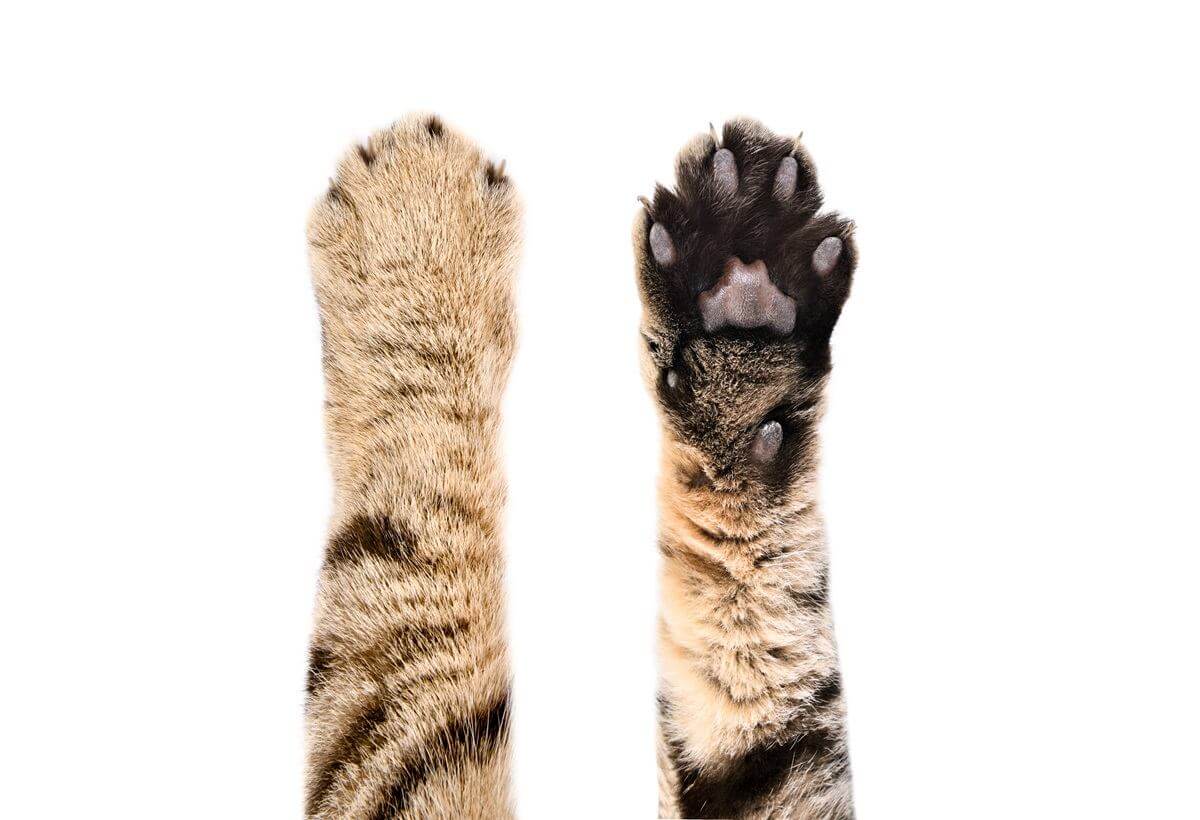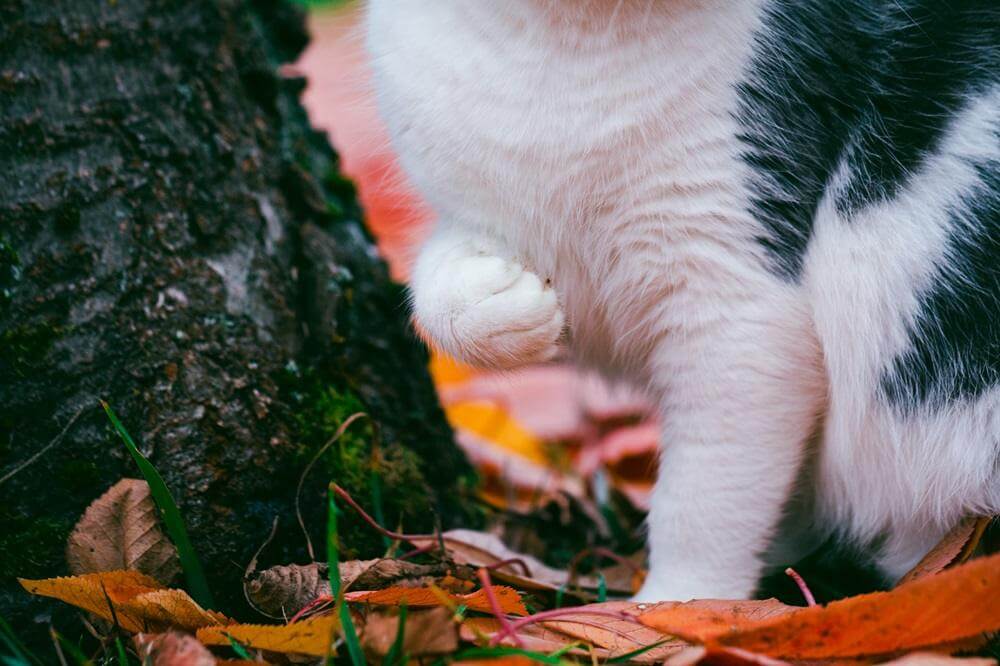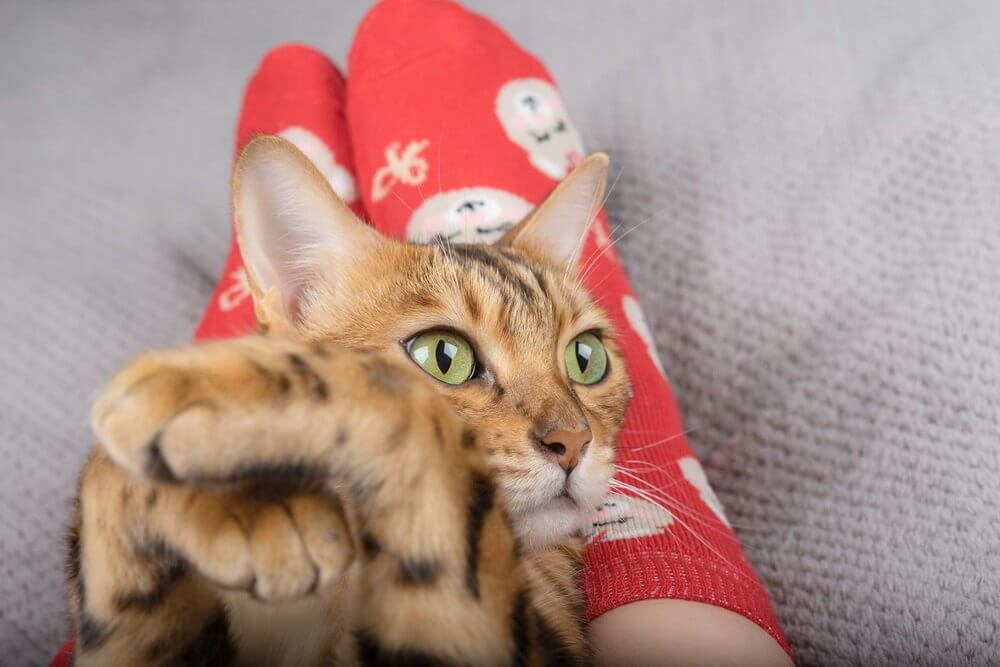

Sonsedska Yuliia / Shutterstock.com
Cutaneous horns are onerous horn-like growths you may see rising out of your cat’s paw pad – a bit like an additional claw. A surprisingly frequent pores and skin situation, they really feel like onerous, thickened bits of pores and skin. It’s because cutaneous horns are constructed from a build-up of keratin, the identical protein that makes up hair, nails, and pores and skin. They’re normally discovered on the ft, however they’ll happen on any a part of the physique – even the face!
In the event that they aren’t on a weight-bearing a part of the paw, these strange-looking lesions aren’t normally painful and don’t trigger any hurt. However like with any new lumps or bumps, it’s a good suggestion to get them checked by your veterinarian. In uncommon circumstances, they are often related to extra critical circumstances corresponding to feline leukemia virus (FeLV), papillomavirus, and sure kinds of tumors.
Learn on to be taught precisely what causes cutaneous horns, when to fret about them, and what to do in case your cat has them.
What Do Cutaneous Horns Look Like?

This cat has a cutaneous horn rising from their stopper pad. Yvette Rowntree / Shutterstock.com
Cutaneous horns are onerous growths that appear like little horns or claws. They’re brownish-yellow and normally vary in hardness from a bit of thickened pores and skin to the identical consistency as your cat’s claw.
They normally develop from the edges of the paw pad or close to the nail mattress, which is why they’re generally mistaken for an additional claw. Some cats solely have one, however they typically have an effect on a number of paw pads. While you’ll most probably discover them across the ft, they’ll truly develop from any a part of your cat’s physique.
What Causes Cutaneous Horns?
Cutaneous horns are brought on by an overgrowth of keratin, a kind of protein. Your cat’s physique wants keratin to supply hair, claws, and the outer layer of their pores and skin. However an excessive amount of keratin could cause additional growths to kind.
More often than not we don’t know what’s brought about the physique to supply the additional keratin—the horns simply seem spontaneously. However in some circumstances, it’s thought that cutaneous horns develop due to extra friction or strain on the paw pads of significantly adventurous cats—identical to calluses on the ft of eager hikers. The repeated strain causes the pad to supply extreme keratin, ensuing within the sexy growths. Some of these cutaneous horns hardly ever trigger issues and should even present some safety in opposition to onerous surfaces.
Nonetheless, often the looks of a cutaneous horn generally is a signal of one thing extra critical. They’re recognized to happen in cats contaminated with feline leukemia, a critical virus that impacts the immune system. Cats contaminated with FeLV are likely to develop cutaneous horns within the heart of the paw pad, versus on the edge. These horns usually tend to trigger discomfort, as they’ll intervene together with your cat’s strolling.
Cats affected by FeLV normally present different indicators of being unwell, corresponding to lethargy or fever. In case your veterinarian is anxious about the opportunity of FeLV, they’ll rule it out with a easy blood take a look at. Nonetheless, in my expertise as a veterinarian, most circumstances of cutaneous horns are innocent and never associated to FeLV.
Different uncommon however vital causes of cutaneous horns embrace papillomavirus an infection, actinic keratoses, and a few kinds of tumors, corresponding to squamous cell carcinomas.
How Are Cutaneous Horns Identified?
Typically, your veterinarian will diagnose a cutaneous horn primarily based on their look alone.
Nonetheless, these growths can appear like different pores and skin circumstances or cancers. In case your vet is not sure or involved they may very well be an indication of one thing extra critical, they might advocate a biopsy. This entails eradicating some or the entire horn and sending it away to be examined below a microscope. This take a look at will distinguish between a innocent cutaneous horn and a distinct kind of pores and skin lesion, together with a tumor.
Your veterinarian may test for FeLV an infection utilizing a easy blood take a look at.
Are Cutaneous Horns Painful for Cats?

Lifting their paw generally is a signal that your cat is in ache. Robert Petrovic / Shutterstock.com
Most cutaneous horns don’t trigger any ache or discomfort. The one time they’ll turn into an issue is that if they kind on a weight-bearing a part of the physique, corresponding to in the direction of the center of a paw pad. Horns positioned right here can press on the paw pad whereas your cat is strolling, inflicting discomfort.
So, while most cutaneous horns don’t harm, it’s vital to look at your cat for any indicators of ache. This might embrace lameness on the horned paw, modifications to exercise ranges, or licking across the space. It’s a good suggestion to look at the horn each few weeks to test for redness, swelling, or discharge which will point out an issue.
For those who’re frightened your cat is perhaps in ache, it’s best to all the time get them checked over by your veterinarian.
Do Cutaneous Horns Require Therapy?
So long as your cat’s cutaneous horn isn’t inflicting them any discomfort, it’s unlikely they are going to want any remedy. You may fear that you must minimize it whether it is rising too lengthy. This may be a good suggestion, however as a veterinarian, I by no means advocate reducing cutaneous horns your self. It’s because it may be difficult to inform horn tissue aside from the wholesome tissue.
By accident reducing wholesome tissue dangers inflicting your cat ache, bleeding, and an infection. So, e-book your cat in with a veterinary skilled when you suppose it wants trimming. They will affirm precisely what it’s, and whether or not it wants any remedy.
In case your cat’s cutaneous horn is inflicting them discomfort, or your veterinarian is frightened about it, they might advocate eradicating it. Surgical removing is usually solely vital for horns rising on a weight-bearing space of the paw pad. Your veterinarian will normally take away the bottom of the horn in addition to the outgrowth to forestall it from regrowing. The eliminated horn might be despatched away to a laboratory to verify it isn’t something to fret about. Most cats recuperate nicely at dwelling after per week or two.
How Can You Assist at House?

In case your cat has cutaneous horns, the very best factor you are able to do is monitor them at dwelling. Svetlana Rey / Shutterstock.com
Until your cat is concerned by their cutaneous horn, you don’t have to do something besides control it. The truth is, as a veterinarian, I might usually advocate leaving them alone until they’re inflicting a problem.
Some cat homeowners strive softening the horn with pet-safe moisturizers or emollients. However in my expertise, that is hardly ever efficient or vital. An important factor you are able to do at house is monitor the horns for any modifications or indicators of discomfort and get it checked when you’re frightened.
Can You Forestall Cutaneous Horns in Cats?
There’s not a lot you are able to do to forestall your cat from creating cutaneous horns. More often than not, cutaneous horns develop spontaneously or just on account of friction on the ft. So, you don’t want to fret about making an attempt to forestall them.
The one vital factor you are able to do is to make sure your cat’s vaccinations are updated. Feline leukemia an infection is a recognized (albeit uncommon) explanation for cutaneous horns in cats. While cutaneous horns hardly ever trigger an issue, FeLV is a life-threatening, incurable situation. The excellent news is you possibly can defend your cat in opposition to FeLV by vaccinating them in opposition to it as kittens and protecting them updated with their annual vaccinations as adults.
Ceaselessly Requested Questions
What causes cutaneous horns in cats?
Cutaneous horns are brought on by an overgrowth of keratin, the protein that makes up hair, pores and skin, and nails. Typically they’re innocent, and both happen spontaneously or in areas of strain on the paw pad (a bit like a callus). Not often, they are often seen with extra critical circumstances corresponding to FeLV, or sure tumors.
How do you eliminate a cutaneous horn on a cat?
Typically, cutaneous horns do not trigger your cat any issues. So, it’s normally greatest to depart them alone. Nonetheless, if they’re inflicting your cat discomfort – or you might be frightened they is perhaps one thing extra critical – it’s best to communicate to your veterinarian about eradicating them. It is usually greatest to not try to trim them at dwelling.
Why does my cat have an additional claw?
Some cats – known as polydactyl cats – have additional toes on their ft. Nonetheless, it is also frequent to mistake a standard pores and skin situation known as “cutaneous horns” for additional toes. These onerous thickened bits of pores and skin typically develop from the paw pads, and may look lots like an additional claw. The excellent news is whether or not your cat has additional toes or a cutaneous horn, each circumstances are normally innocent.
Can I minimize my cat’s cutaneous horns?
As a veterinarian, I by no means advocate that homeowners minimize their cat’s cutaneous horns at dwelling. It’s because it may be onerous to inform the onerous pores and skin aside from wholesome pores and skin, risking bleeding, ache, and an infection. It is all the time most secure to take your cat to the veterinarian to allow them to study the horn, affirm the prognosis, and advocate the easiest way to deal with them – in the event that they want any remedy in any respect.
Is it regular for cats to have calluses?
Sure! Identical to us, cats can get calluses on their ft after they do a number of strolling. The strain and friction on the paw pads could cause an overgrowth of keratin, leading to areas of onerous pores and skin known as “cutaneous horns”. These are normally innocent, nevertheless it’s all the time value getting any new lesion checked by a veterinarian.